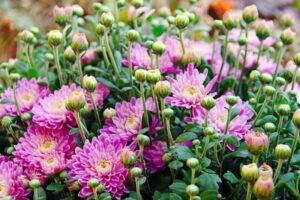On this page, we will discuss an array of flowers and plants that are ideally suited to be planted alongside a sidewalk, considering their aesthetic appeal, ease of maintenance, and adaptability to various conditions.
Thrift
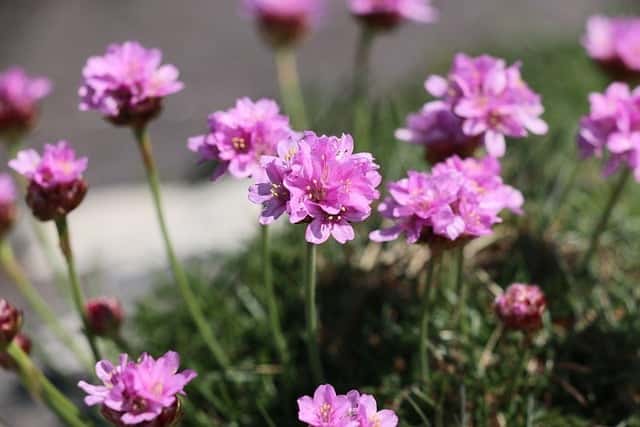
One of the first flowers to consider for your sidewalk is Thrift (Armeria maritima). Known for its charming, pom-pom-like blooms, this perennial plant thrives in sunny areas and prefers well-drained soils. Thrift is hardy and drought-tolerant once established, making it an excellent choice for those who want to conserve water and minimize maintenance.
With its evergreen foliage, Thrift provides visual interest even when it’s not in bloom. The flowers bloom in late spring to early summer, producing vibrant clusters in shades of pink, red, or white. Their compact growth makes them perfect for edging along sidewalks, creating a tidy, colorful border that will attract bees and butterflies.
Additionally, Thrift can tolerate salty air and poor soils, making it a fantastic option for coastal gardens or urban environments where conditions can be less than ideal.
Impatiens

If your sidewalk is flanked by shaded areas, then Impatiens (Impatiens walleriana) can work wonders. Known for their bold, vibrant colors and ability to thrive in low light, these annuals are an excellent choice to brighten up darker spaces. They come in myriad hues— from deep reds to soft pinks, white, and even bi-colors—allowing for creative combinations based on your aesthetic preferences.
While they require regular watering to flourish, Impatiens are relatively low-maintenance beyond that. Simply ensure they receive ample light and do not let the soil dry out completely. Their lush foliage and bright flowers create a welcoming atmosphere, making your sidewalk a pleasant walk for passersby.
Moreover, impatiens are perfect for adding depth to flower beds—just group them near the walkway to create a cascading effect that draws the eye. For those looking to create a cozy nook or secret garden, planting them beside the sidewalk can provide an inviting, intimate touch.
Dianthus
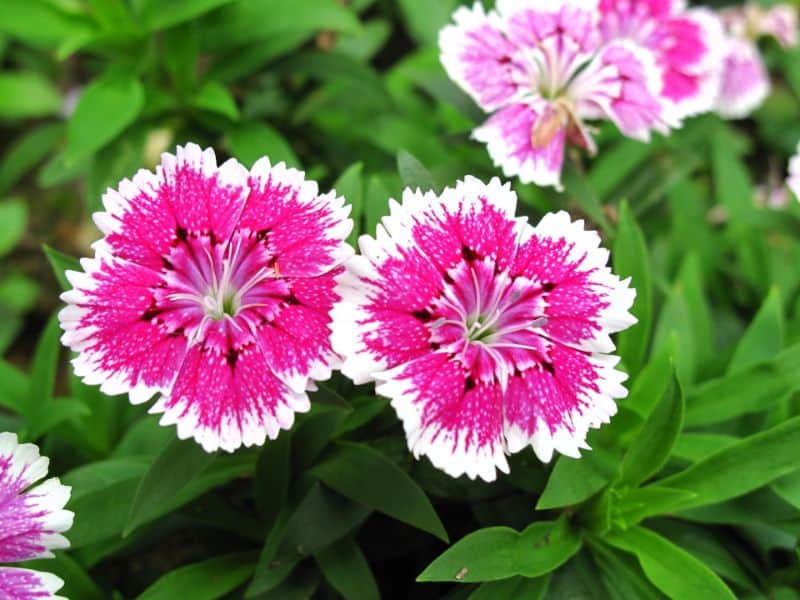
Adding a pop of color and delightful fragrance can be easily achieved by planting Dianthus (Dianthus spp.) near your sidewalk. Often referred to as “pinks” due to their fringed edges, these charming perennials bloom in vibrant shades of pink, red, and white throughout late spring.
Dianthus is particularly versatile; they establish well in various soil types as long as they’re well-drained, and they thrive in full sun. These plants not only add beauty but also attract pollinators, enhancing the biodiversity of your garden.
A unique quality of Dianthus is its resilience to foot traffic. Their compact growth and strong stems mean that they can withstand occasional trampling, making them ideal for areas near busy walkways. Consider creating clusters of these flowers to inject lively bursts of color that transform a mundane sidewalk into a floral wonderland.
Lamb’s Ears
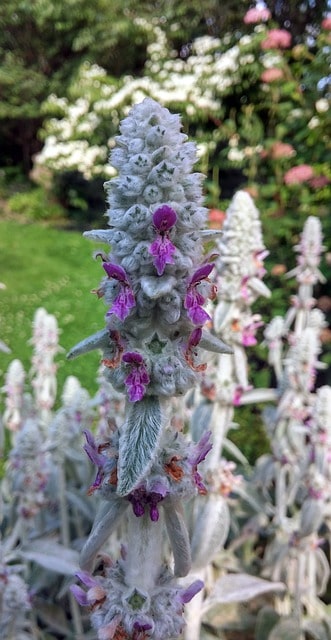
For a truly unique addition to your sidewalk garden, Lamb’s Ears (Stachys byzantina) present a soft, silvery texture that stands out distinctly from traditional leafy greens. This perennial plant is adored for its fuzzy leaves, adding an intriguing sensory element. While it does produce small spikes of purple flowers in late spring, it’s primarily valued for its striking foliage.
Lamb’s Ears prefer full sun to partial shade and perform best in well-drained soil. Their drought-resistant nature means they’ll flourish during drier periods, making them a great choice for homeowners looking to minimize irrigation.
For sidewalks, planting Lamb’s Ears in clusters adds depth and interest to your garden, while also softening the hardscape of walkways. Their unique texture and ability to thrive in various conditions bring a touch of whimsy and charm to your outdoor space.
Dahlia
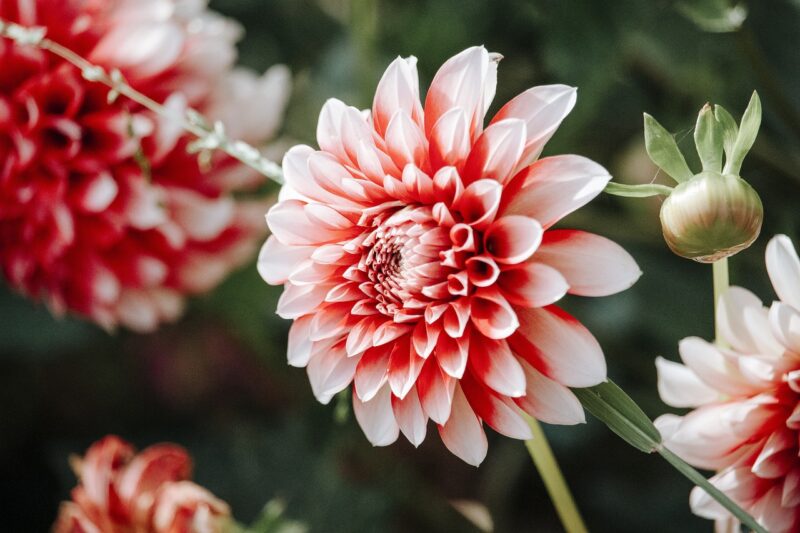
Dahlias are among the most vibrant and diverse flowering plants one can grow, making them a fantastic option for those who want a show-stopping sidewalk garden. With blooms ranging from soft pastels to bold jewel tones, dahlias can provide visual appeal throughout the summer and into early fall.
These tuberous perennials come in various shapes and sizes, allowing you to mix and match for a personalized garden aesthetic. They do require a bit more care; ensuring they have fertile soil and ample sunlight is crucial to their success. However, the reward is immense—lush blooms can stand impressively tall or bloom as compact mounds, depending on the variety chosen.
When planted neatly along sidewalks, Dahlias create a beautiful visual guide that entices guests and neighbors alike. Their long-lasting blooms also make them excellent for cutting, so you can enjoy the beauty of your garden inside as well.
Astilbe

Astilbe is a flowering perennial that brings grace and color to shaded or partially shaded areas, making it an excellent choice for sidewalks that are less exposed to sun. With feathery plumes that can make a grand statement, these flowers bloom in a variety of colors, including pink, white, and red.
Astilbe flourishes in moist, well-draining soil, meaning that they are ideal for areas where rainwater collects. Their ability to thrive in damp conditions makes them perfect for those sheltered from direct sunlight, creating a lush, inviting look along your walkway.
With their elegant spikes of flowers and fern-like foliage, Astilbe plants can create a serene atmosphere—perfect for those who enjoy tranquil garden strolls. They also attract hummingbirds and butterflies, contributing to the biodiversity of your garden and providing a lively ambiance.
Daylily
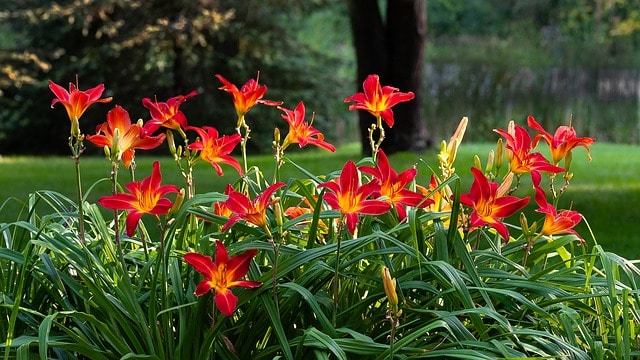
Daylilies (Hemerocallis spp.) are stalwarts in any sidewalk garden, celebrated for their hardiness and low-maintenance nature. These perennial plants can adapt to a range of soil types and growing conditions, making them incredibly versatile for gardeners. Their vibrant blooms appear in various hues, from yellows to deep purples.
One commendable trait of daylilies is their long blooming season. These beauties usually flower in late spring and can last through summer, providing visual interest throughout various projects. With their strong roots and resilience, they can thrive in various weather conditions, including periods of drought.
When planted alongside your sidewalk, Daylilies can create an effortless, whimsical charm. Their flowers open in the morning and typically fade in the evening, yet they consistently produce new blooms, ensuring continuous beauty throughout the seasons.
Coral Bells
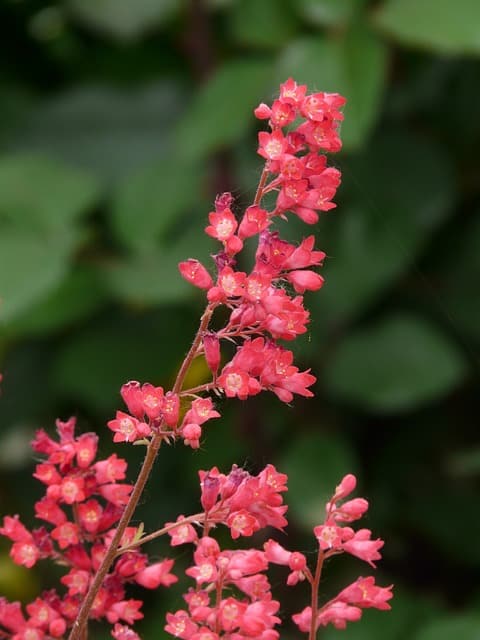
Offering a range of colors and textures, Coral Bells (Heuchera) make an appealing addition to any sidewalk landscape. With their striking foliage that showcases various shades—from deep burgundy to bright lime green—Coral Bells can brighten up even the shadiest spots.
These perennial plants thrive in well-draining soil and can tolerate partial shade, making them perfect for areas with limited sunlight. Their delicate flower spikes, which rise above the foliage, bloom from late spring to early summer in hues of pink, white, and red, providing added interest.
Coral Bells are unlikely to grow overly invasive, so they’re a perfect choice for edging a sidewalk without taking control of the space. Plant them in clusters to create beautiful contrasts and layers of foliage that can turn a simple path into a botanical masterpiece.
Catmint
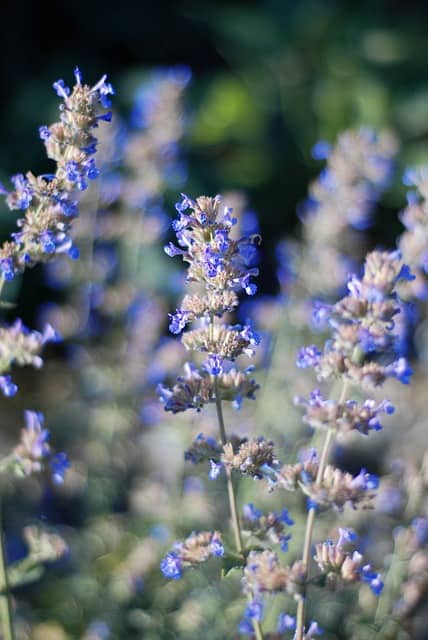
Catmint (Nepeta) is a fantastic choice for those looking to attract pollinators while creating a dense and aromatic border along their sidewalk. Known for their lavender-blue flowers and aromatic foliage, Catmint is also a magnet for bees, butterflies, and other beneficial insects.
This perennial plant thrives in well-draining soil with plenty of sunlight. It produces long-lasting blooms throughout the summer and requires minimal watering once established. The light green, fragrant leaves—often likened to mint—release a delightful scent when brushed against, adding to the sensory experience of your sidewalk garden.
Due to their vigorous growth habit, planting Catmint along sidewalks can create a fragrant, colorful buffer. Their natural drought tolerance further reduces the need for maintenance, allowing you to enjoy their beauty without major effort.
Rhododendron
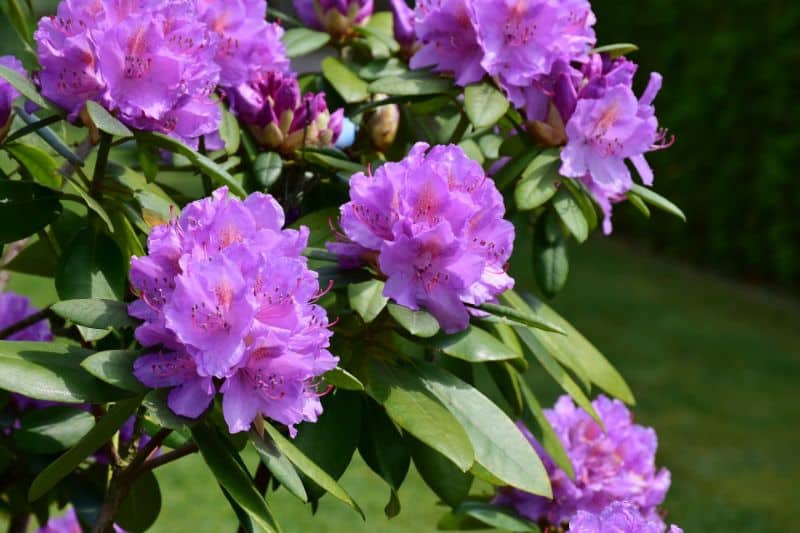
For a bold, eye-catching presence near your sidewalk, Rhododendrons (Rhododendron spp.) offer stunning blooms and lush foliage. Known for their spectacular clusters of flowers in spring, these shrubs are fantastic for adding vertical interest and depth along walkways.
Rhododendrons thrive in acidic, well-drained soil and require partial shade for optimal growth. Pouring energy into the care of these plants yields magnificent rewards with their vibrant displays. The various species range in size, allowing for flexible landscaping options, from low hedges to tall stands of stunning blooms.
When planted along sidewalks, Rhododendrons create a delightful burst of color and fragrance, serving as a magnificent anchor point in your garden. Their leaves provide afternoon shade to nearby plants, ensuring a balanced environment while attracting birds and pollinators to your garden.
Moss Rose
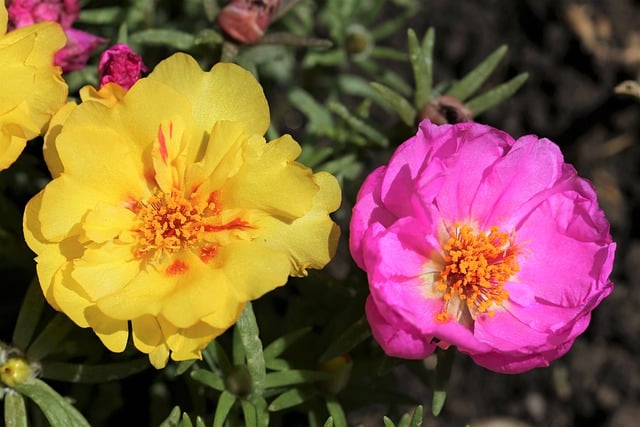
If you’re searching for an incredibly resilient and colorful option to adorn your pavement, consider the low-growing Moss Rose (Portulaca oleracea). This annual plant thrives in poor soil conditions and requires very little water, making it ideal for low-maintenance gardens.
Moss Rose features succulent leaves and vibrant blooms that open in sunny weather, available in colors like purple, yellow, and pink. When planted in the cracks of a sidewalk or as a border, their sprawling nature creates an interesting, laid-back effect—imparting a casual charm to your path.
With their toughness and ability to endure harsh weather, Moss Rose will continue to thrive even under the wear and tear of foot traffic. Because they bloom continuously from late spring to fall, they ensure a lively and cheerful atmosphere near your sidewalk.
Liriope
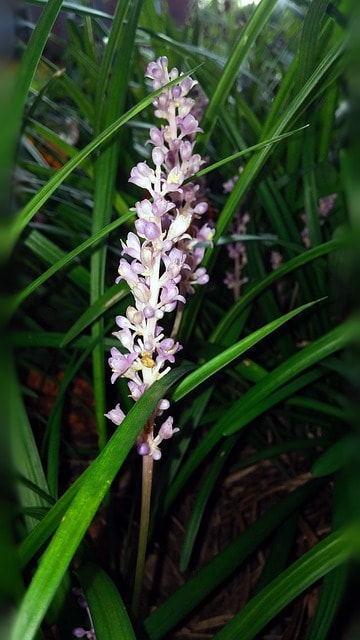
Another outstanding plant choice for edging a sidewalk is Liriope (Liriope muscari), also called monkey grass. This hardy perennial is known for its grassy foliage and small, lavender flower spikes that emerge in late summer. Liriope thrives in various light conditions, from full sun to partial shade, making it a versatile option for different environments.
As a low-maintenance ground cover plant, Liriope provides excellent texture and form while remaining resistant to pests. Once established, it requires minimal watering and is effective at preventing erosion, especially in sloped areas.
Plants like Liriope can encapsulate a sidewalk beautifully, creating a natural line between your path and bed areas. The subtle, purple blooms that emerge during the warm months add a pop of interest while maintaining an elegant and neat appearance.
Fountain Grass
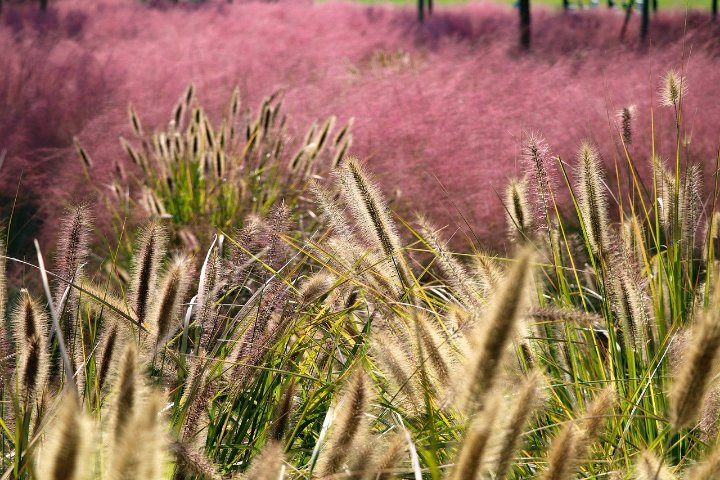
Finally, for a touch of drama with graceful movement, consider planting Fountain Grass (Pennisetum spp.) alongside your sidewalk. This ornamental grass brings beautiful texture and height, especially when swaying gently in the breeze.
Fountain Grass thrives in full sunlight and well-drained soil, and it requires minimal maintenance once established. Its feathery flower plumes begin to form in late summer and can last well into fall, providing interest even as other plants begin to fade away.
When used to frame a sidewalk, Fountain Grass can create a striking contrast to shorter flowering plants, lending a dynamic and sophisticated feel. The flowing, softest movement adds both elegance and a natural charm to your garden space.



